Art & Exhibitions
What Would It Mean to See Beyond Colonialism? In Berlin, an Exhibition and a Mobile School Look for Answers
The Daimler Collection and Savvy Contemporary offer ways to think of new models of art and design.
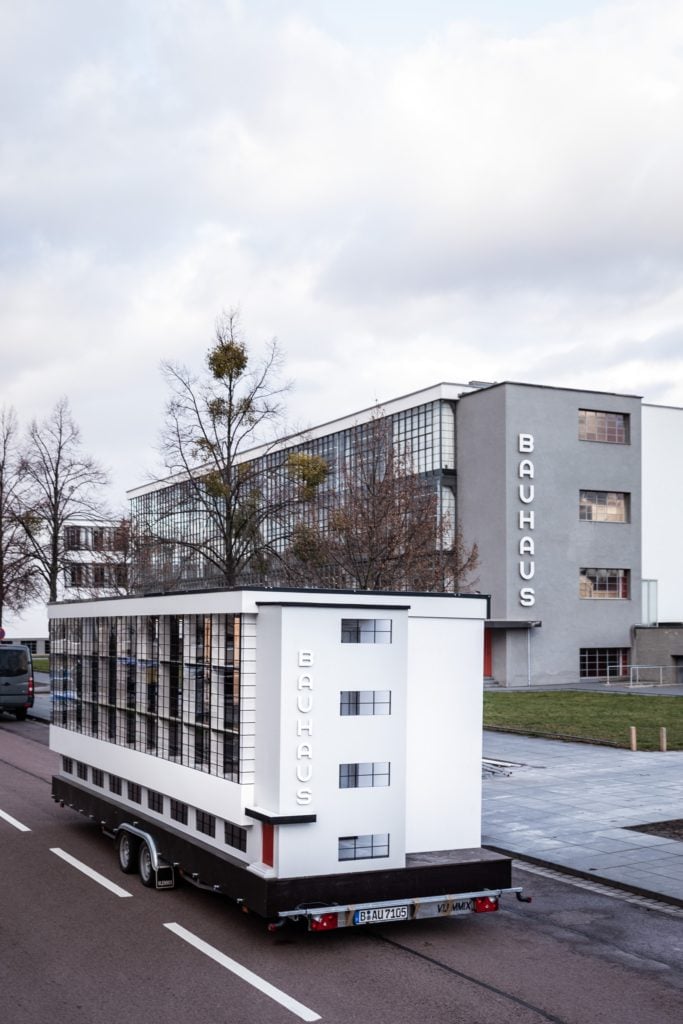
The Daimler Collection and Savvy Contemporary offer ways to think of new models of art and design.

Mebrak Tareke

When we think of Africa and colonialism, Germany may not be the first country that springs to mind. However, the Berlin Conference of 1884-1885 was arguably where the Scramble for Africa began to take shape, leading to the continent’s partition and looting at the hands of European colonial rule over the course of the 19th and the 20th centuries.
The day I went to see “Evoking Reality” at the Daimler Collection in Berlin, I couldn’t help but think about this history. The show, which consists of a selection of political photography and video that’s been acquired by the institution, says it’s devoted to “contemporary strategies that distance themselves from established principles of representation”—and it touches, among other things, on questions of rethinking the colonial gaze.
Similarly, “Spinning Triangles,” an ambitious pop-up intervention by the non-profit creative laboratory SAVVY Contemporary, which was timed to coincide with the centennial of the Bauhaus, tackled how we might frame the history and perception of art and design from Africa, outside the echo chambers of modern European history.
Although they’re very different, when seen together, these two shows conjure some provocative thoughts about various ways of unlearning the flaws of the past.
Seeing Differently
The design of “Evoking Reality” provokes questions about the prism of colonial history. Even though it contains work by figures such as Cao Fei and Tacita Dean, a number of the 16 artists on view are either from Southern Africa or they’re depicting the continent, in some shape or form. Let’s consider the contrast between two of the photographers in the show: Pieter Hugo and Guy Tillim.
They’re both from South Africa, and they’re both white, yet they paint starkly opposing impressions of the people they encounter, who, in this show, are always black. There’s something quite earnest about Tillim’s snapshots. You’d think he lived and worked among his subjects, who are often captured drifting through downtown Nairobi, Harare, or Kinshasa.
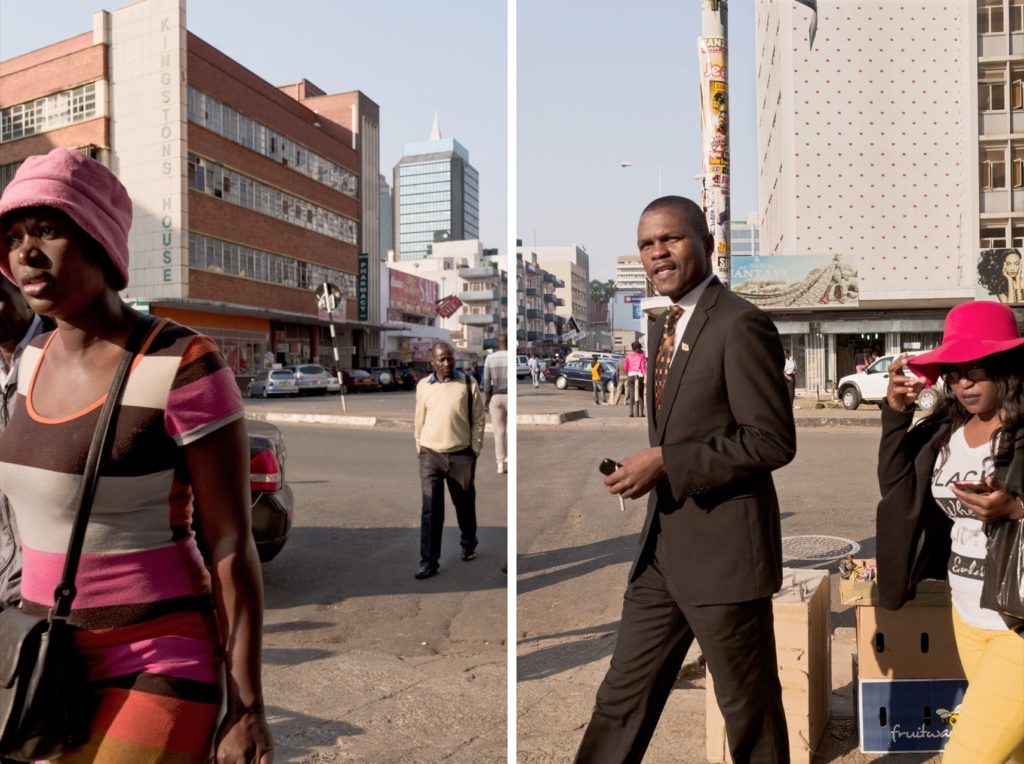
Guy Tillim, Harare, diptych (2009). © Guy Tillim, Courtesy Stevenson, Cape Town/Johannesburg.
In Harare (2016), men and women are pictured simply going about their daily lives as though no one were looking. He captures these pedestrians in motion, as they move briskly through the city’s streets on their way somewhere. This could be anywhere and it seems to strike Tillim as nothing short of ordinary.
On the other hand, Pieter Hugo’s works embellish reality, offering a more distorted journey into his subject’s lives. In Portrait #12, Rwanda (2015), we see a young girl dressed in a pink lace dress, stretched out, posing against a patch of deep red soil. She looks vacant and lifeless. There’s something unsettling about how contrived Hugo’s subject seems, posing for the camera, looking quite precocious in a sea of seductive pink and red.
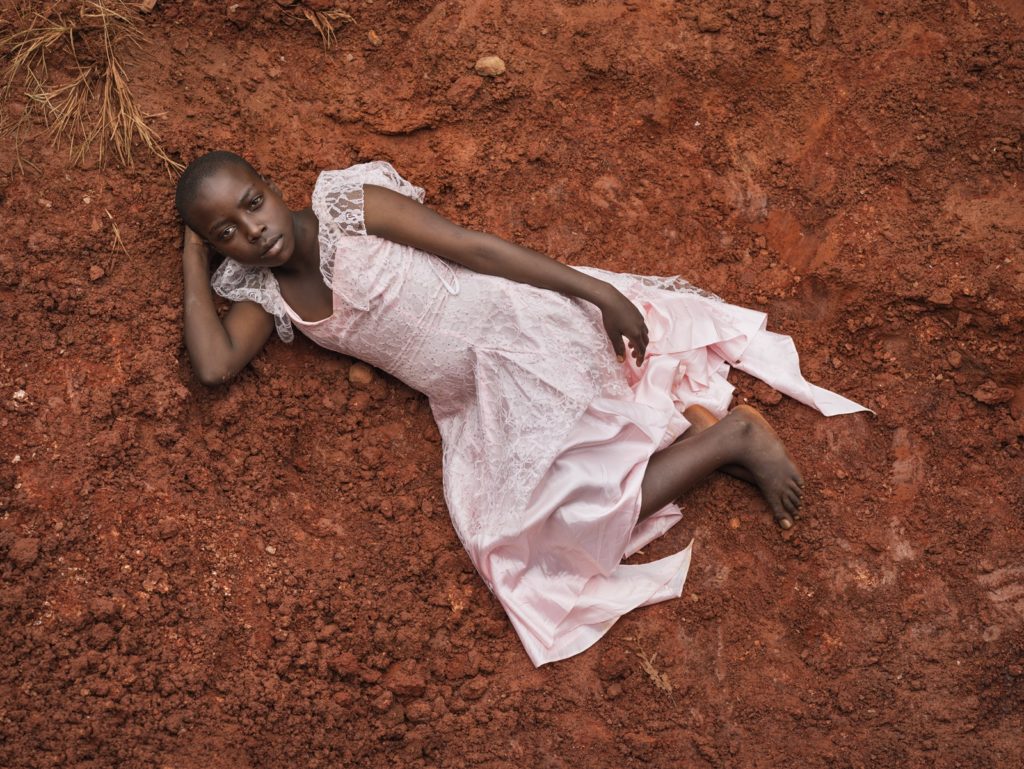
Pieter Hugo, Portrait #12, Rwanda (2015). Image courtesy Daimler Contemporary.
Such imagery makes me wonder how Hugo’s own gaze has shaped the ways in which viewers might perceive the subject matter. You could argue that a “white” photographer couldn’t possibly see what locals see—but then, this doesn’t feel true of Tillim’s works, which aren’t quite as uncanny as Hugo’s. Portrait #12 is part of a series that depicts children, who are always seen alone, in post-genocide Rwanda; the photographer himself says that he was looking to evoke the novel Lord of the Flies.
A more ambiguous, aesthetic gaze can, at times, distance us from a sense of lived reality—but it can also offer new possibilities for experiencing identity. One work in “Evoking Reality” was particularly thought-provoking: Snow White by Berni Searle taught me that we can feel and embody the pain of others. In this two-screen video installation, the artist, who is also South African, uses her own naked body to complicate how we perceive her.
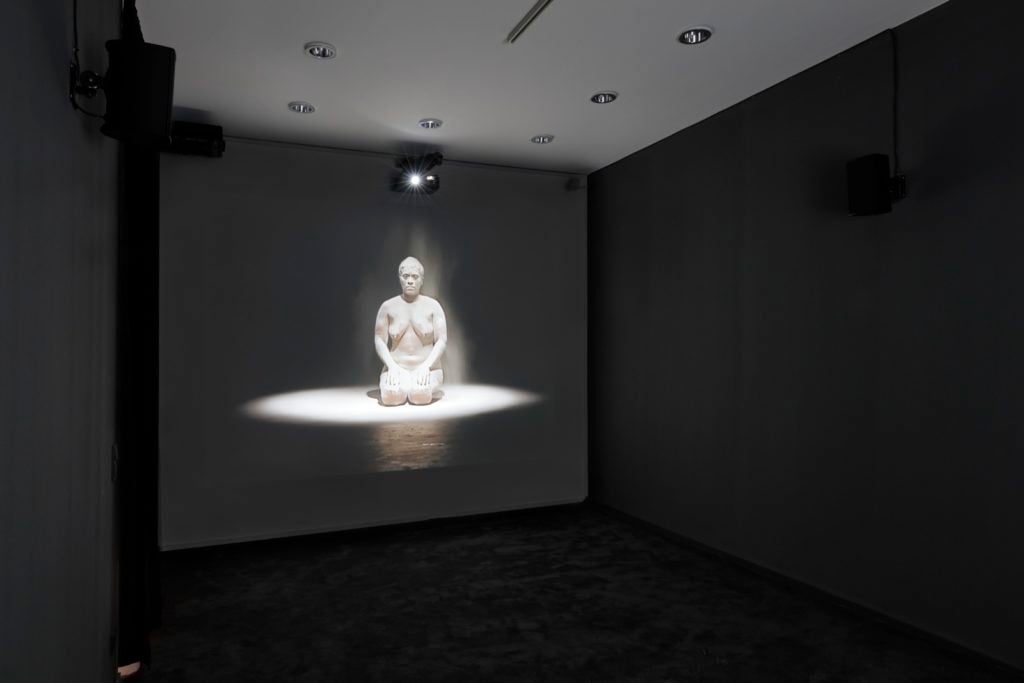
Installation view of Berni Searle, Snow White in “Evoking_Reality.” Image courtesy Daimler Contemporary.
In it, Searle—bare-chested and doused in a mound of white flour—uses kneading dough as a metaphor for exploring the embodiment of pain and transformation. She cuts an ambiguous figure that defies easy cues about age, gender, and identity. Beneath the white powder, we can hardly discern that she is in fact of mixed race.
And soon we realize that this ambiguity is really the point, since she sets out to explore, in her own words, “what identity can be beyond categorical attributions.” Here, Searle is constantly morphing into different versions of herself. Yet we continue to relate to her, nonetheless, seeing a bit of ourselves in these fleeting moments.
SAVVY Contemporary was founded in Berlin by curator Bonaventure Soh Bejeng Ndikung (he was a curator-at-large on the last documenta, and is set to curate the upcoming Sonsbeek Exhibition in the Netherlands in 2020). It sets out to decolonize the past, the present, and the future through public installations such as “Spinning Triangles,” a remarkable intervention that consisted of a miniature version of the “workshop wing” of Walter Gropius’s seminal Bauhaus building in Dessau, on wheels.
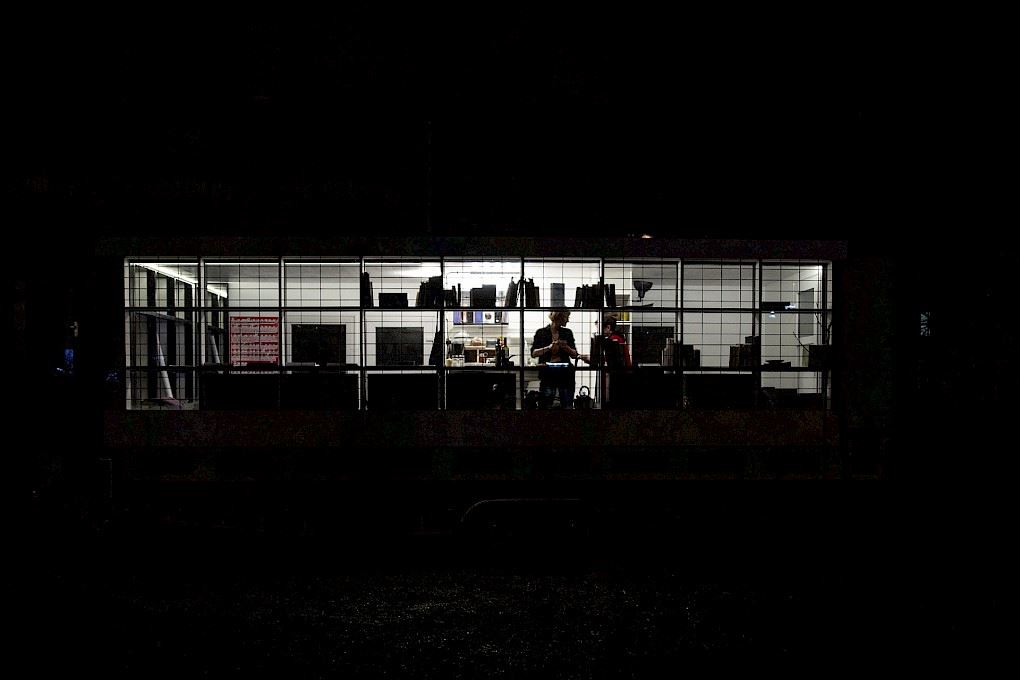
The Wohnmaschine, a tinyhouse version of the Dessau bauhaus conceived by Van Bo Le-Mentzel, in front of the original workshop wing. Photo by Mirko Mielke, image courtesy SAVVY Contemporary.
On a cold rainy Sunday afternoon in late January, I found this tiny mobile house parked right outside the opening of the “100 Years of Bauhaus” festival at Berlin’s Akademie der Kunst. It was there to protest the centenary. As people drifted in and out of the vehicle, one of the curators, Elsa Westreicher, was on hand to make a point: that Africa has something to teach both Europe and the Bauhaus about the history of design and architecture. Inside, you could peruse books about the history of colonialism and design, leaning on makeshift bookshelves. The selection evoked the challenges of “inherent, neocolonial power structures in design practices, theory and teaching,” offering new ways of imagining design instead.
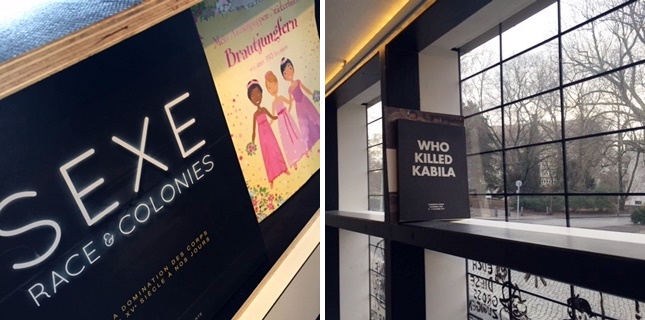
Left and right: two views of details of SAVVY Contemporary’s “Spinning Triangles.” Photos courtesy Mebrak Tareke.
In its statement about “Spinning Triangles,” SAVVY Contemporary argues that “[w]e recognize the Bauhaus not only as a solution, but also as a problem, and will propose a school of design that may well become an ‘un-school.”
It’s not immediately obvious why the theme for “Spinning Triangles” was inspired by the centenary of the Bauhaus, Germany’s foremost school of architecture and design that lasted, officially, from 1919 to 1933. It began in Weimer, carrying on in Dessau and right here in Berlin. The Bauhaus shaped modern European architecture and design, that’s for sure, and this influence then spread across the world. There’s also an overall sense that, until quite recently, “architecture in Africa was also driven primarily by the Bauhaus principal of functionality,” according to journalist Michele Koh Morollo.
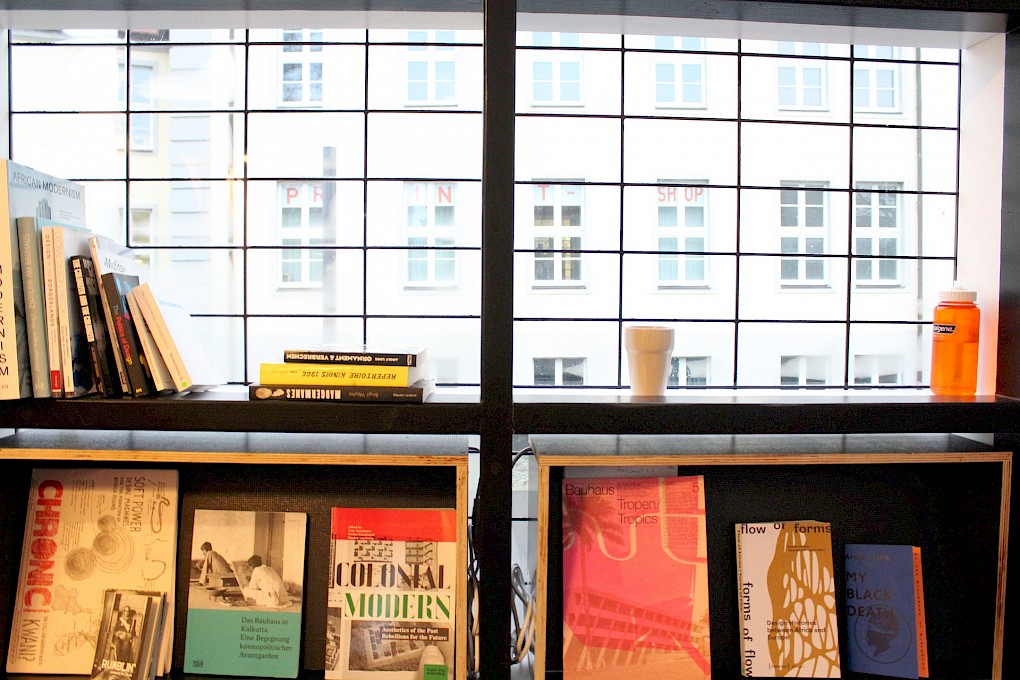
Interior of the Wohnmaschine. Photo by Mirko Mielke, image courtesy SAVVY Contemporary.
“Spinning Triangles” didn’t present us with a full survey of this linkage. It seems to be making more of a provocative statement against the image of the Bauhaus hijacking how we understand design thinking as a whole. The project brief for “Spinning Triangles” insists that the new, necessary kind of design institution it models “will not be developed by the geopolitical west, but through the accelerated movement between deeply interwoven places—Dessau, Kinshasa, Berlin, and Hong Kong.” “Spinning Triangles” is here to tell us that we need to unlearn the past by engaging ideas that have, do, and will continue to exist in non-Western contexts.
The concept and physical intervention of SAVVY Contemporary’s tiny house is quite appealing. What remains to be imagined is what form this other, trans-national school of thought might take in the long-term. How might reversing the flow of ideas shape the face of architecture and design across Africa and the diaspora? “Spinning Triangles,” the concept—though not the actual tiny house—has just left Kinshasa; on Instagram, the curators posted that they are still processing everything. Plans are also underway for a range of events in the near future—so we’ll just have to wait and see where this all leads.
I saw both these shows, “Spinning Triangles” and “Evoking Reality,” on the same day. One thing seeing them juxtaposed taught me is that there are several histories and, indeed, multiple ways of seeing ourselves and those around us. Although neither show claims to have the answers on how to exist outside the grip of modern European history, they both go some way in ensuring that we are made fully aware, as Zadie Smith once said, that “every moment happens twice: inside and outside, and they are two different histories.”